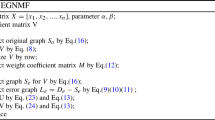Abstract
Non-negative matrix factorization (NMF) is a recently popularized technique for learning parts-based, linear representations of non-negative data. Although the decomposition rate of NMF is very fast, it still suffers from the following deficiency: It only revealed the local geometry structure; global geometric information of data set is ignored. This paper proposes a manifold ranking graph regularization non-negative matrix factorization with local and global geometric structure (MRLGNMF) to overcome the above deficiency. In particular, MRLGNMF induces manifold ranking to the non-negative matrix factorization with Sinkhorn distance. Numerical results show that the new algorithm is superior to the existing algorithm.




Similar content being viewed by others
References
Lee Daniel D, Sebastian Seung H (1999) Learning the parts of objects by non-negative matrix factorization. Nature 401:788–791
Lee DD, Sebastian Seung H (2001) Algorithms for non-negative matrix factorization. Proc Neural Inf Process Syst 13:556–562
Xu J, Xiang L, Wang G, Ganesan S, Feldman M, Shih NNC, Gilmore H, Madabhushi Anant (2015) Sparse non-negative matrix factorization (SNMF) based color unmixing for breast histopathological image analysis. Comput Med Imaging Graph 4(46):20–29
Yan X, Guo J, Liu S, Cheng XQ, Wang Y (2012) Clustering short text using ncut-weighted non-negative matrix factorization. In: Conference on information and knowledge management, 2259–2262
Li Y, Alioune N (2013) The non-negative matrix factorization toolbox for biological data mining. Source Code Biol Med 8(1):10–10
Yang Z, Yuan Z, Laaksonen J (2011) Projective non-negative matrix factorization with applications to facial image processing. Int J Pattern Recognit Artif Intell 21(08):1353–1362
Raj B, Virtanen T, Chaudhuri S, Singh R (2010) Non-negative matrix factorization based compensation of music for automatic speech recognition. In: Conference of the international speech communication association
Lopes N, Ribeiro B (2010) Non-negative matrix factorization implementation using graphic processing units. In: Intelligent data engineering and automated learning, 275–283
Paritosh P, Applegate BE, Jo JA (2012) Application of non-negative matrix factorization to multispectral FLIM data analysis. Biomed Optics Express 3(9):2244–2262
Cai D, He X, Han J, Huang TS (2011) Graph regularized nonnegative matrix factorization for data representation. IEEE Trans Pattern Anal Mach Intell 33(8):1548–1560
Tolic D, Antulov-Fantulin N, Kopriva I (2018) A nonlinear orthogonal non-negative matrix factorization approach to subspace clustering. Pattern Recognit 82(04):40–45
Zhang H, Wang S, Xu X, Chow TWS, Jonathan Wu QM (2018) PTree2Vector: learning a vectorial representation for tree-structured data. IEEE Trans Neural Netw Learn Syst 99:1–15
Sandler R, Lindenbaum M (2011) Nonnegative matrix factorization with earth movers distance metric for image analysis. Pattern Anal Mach Intell 33(8):1590–1602
Qian W, Hong B, Cai D, He X, Li X (2016) Non-negative matrix factorization with Sinkhorn distance. In: Proceedings of the twenty-fifth international joint conference on artificial intelligence (IJCAI-16), 1960–1966
Rubner Y, Tomasi C, Guibas LJ (2000) The earth mover’s distance as a metric for image retrieval. Int J Comput Vis 40(2):99–121
Cuturi M (2013) Sinkhorn distances: lightspeed computation of optimal transport. In: Advances in neural information processing systems, 2292–2300
Ma L, Li H, Meng F, Qingbo W, Linfeng Xu (2017) Manifold-ranking embedded order preserving hashing for image semantic retrieval. J Vis Commun Image Represent 44(2017):29–39
Nene SA, Nayar SK, Murase H (2011) Columbia object image library (COIL-20). In: Computer
Samaria FS, Harter AC (1994) Parameterisation of a stochastic model for human face identification. In: IEEE workshop on applications of computer vision, 138–142
Acknowledgements
This research has been supported by the National Natural Science Foundation of China (No. 71561008, 11601012), Guangxi Natural Science Foundation (No. 2018GXNSFAA138169), Guangxi Key Laboratory of Cryptography and Information Security No. GCIS201708) Guangxi Key Laboratory of Automatic Detecting Technology and Instruments (No. YQ19111, YQ18112), GUET Excellent Graduate Thesis Program (16YJPYSS22).
Author information
Authors and Affiliations
Corresponding author
Additional information
Publisher's Note
Springer Nature remains neutral with regard to jurisdictional claims in published maps and institutional affiliations.
A Appendix
A Appendix
In order to prove Theorem 1 and deduce u, v update iterative formulas, similar to reference [2], we set Definition 1 [2] and Lemma 1 [2].
Definition 1
[2] \(G(\upsilon ,\upsilon ^{\prime })\) is an auxiliary function for F(v) if the conditions
are satisfied.
The auxiliary function is very useful because of the following lemma.
Lemma 1
[2] IfGis an auxiliary function ofF, thenFis non-increasing under the update
Now, we will show that the update step for V in (3.4) with a proper auxiliary function. We rewrite the objective function \({\mathcal {O}}\) of MRLGNMF as follows:
Now, we prove the updated iteration formula u, v and Theorem 1.
Lemma 2
It can be seen from reference [2] that the function\(G(v,v^{q})\)is the auxiliary function of the objective function\({\mathcal {O}}\). The function\(G(v,v^{q})\)is related to the auxiliary function ofv, where
Now, we set \({\mathcal {L}}_{\mathcal {O}}\) is Lagrange function of the objective function \({\mathcal {O}}\), and the \({\mathcal {L}}_{\mathcal {O}}\) is rewritten as
Then, we find partial derivatives of \({\mathcal {L}}_{\mathcal {O}}\) with respect to U and V, with KKT conditions \(\varphi _{ij}u_{ij}=0\) and \(\phi _{ij}v_{ij}=0\), and based on the above many parts, we get the objective function \({\mathcal {O}}\) for u and v for the update iteration formula as follows:
where \(\varphi =\zeta \mu \), F is updated in accordance with equation (3.2), and \(F_{ij}^{+}=\frac{|F_{ij}|+F_{ij}}{2}\), \(F_{ij}^{-}=\frac{|F_{ij}|-F_{ij}}{2}\).
Rights and permissions
About this article
Cite this article
Li, X., Yu, J., Dong, X. et al. Manifold ranking graph regularization non-negative matrix factorization with global and local structures. Pattern Anal Applic 23, 967–974 (2020). https://doi.org/10.1007/s10044-019-00832-0
Received:
Accepted:
Published:
Issue Date:
DOI: https://doi.org/10.1007/s10044-019-00832-0




